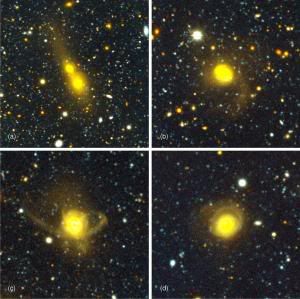It looks like you're using an Ad Blocker.
Please white-list or disable AboveTopSecret.com in your ad-blocking tool.
Thank you.
Some features of ATS will be disabled while you continue to use an ad-blocker.
0
share:

On the right we can see several galaxy collisions in the nearby universe. The image shows pairs of galaxies in different stages of the merger process. These photos were taken by the NOAO Deep Wide-Field Survey (NDWFS) and the Multiwavelength Survey by Yale/Chile (MUSYC).
They still don't understood why the colliding galaxies do not lead to enhanced star formations. Sometimes instead of getting more answers in the Universe we are left with more questions.
www.sciencedaily.com
Galaxy Collisions Dominate The Local Universe
More than half of the largest galaxies in the nearby universe have collided and merged with another galaxy in the past two billion years, according to a Yale astronomer in a study using hundreds of images from two of the deepest sky surveys ever conducted.
The idea of large galaxies being assembled primarily by mergers rather than evolving by themselves in isolation has grown to dominate cosmological thinking. However, a troubling inconsistency within this general theory has been that the most massive galaxies appear to be the oldest, leaving minimal time since the Big Bang for the mergers to have occurred.
“Our study found these common massive galaxies do form by mergers. It is just that the mergers happen quickly, and the features that reveal the mergers are very faint and therefore difficult to detect,” said Pieter van Dokkum, assistant professor of astronomy at Yale University, and sole author of the paper appearing in the December 2005 issue of the Astronomical Journal.
Please visit the link provided for the complete story.
new topics
-
President BIDEN's FBI Raided Donald Trump's Florida Home for OBAMA-NORTH KOREA Documents.
Political Conspiracies: 3 hours ago -
Maestro Benedetto
Literature: 4 hours ago -
Is AI Better Than the Hollywood Elite?
Movies: 4 hours ago -
Las Vegas UFO Spotting Teen Traumatized by Demon Creature in Backyard
Aliens and UFOs: 8 hours ago -
2024 Pigeon Forge Rod Run - On the Strip (Video made for you)
Automotive Discussion: 9 hours ago -
Gaza Terrorists Attack US Humanitarian Pier During Construction
Middle East Issues: 9 hours ago -
The functionality of boldening and italics is clunky and no post char limit warning?
ATS Freshman's Forum: 10 hours ago -
Meadows, Giuliani Among 11 Indicted in Arizona in Latest 2020 Election Subversion Case
Mainstream News: 11 hours ago -
Massachusetts Drag Queen Leads Young Kids in Free Palestine Chant
Social Issues and Civil Unrest: 11 hours ago
0
